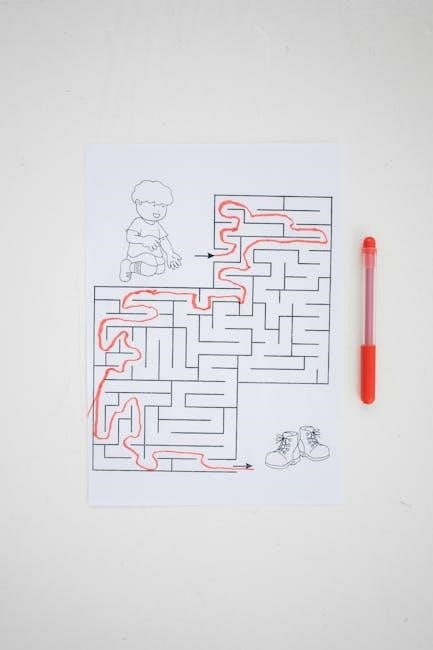The crossword clue “Site with Tutorials” has gained popularity among enthusiasts, offering a fun challenge to uncover the correct answer. Common solutions include “EHOW,” a well-known DIY tutorial platform. This clue tests knowledge of educational websites, making it a great brain teaser for puzzle lovers.
Overview of Crossword Puzzles and Their Popularity
Crossword puzzles are a beloved pastime worldwide, offering mental stimulation and relaxation. They appear daily in newspapers, magazines, and online platforms, attracting a diverse audience. The popularity of crosswords lies in their ability to challenge vocabulary, memory, and logical thinking. Over time, crosswords have evolved, incorporating themes and varying difficulty levels, from simple early-week puzzles to complex cryptic ones. Their enduring appeal fosters a sense of accomplishment and community among solvers, making them a timeless entertainment medium.
Importance of Solving Crossword Clues
Solving crossword clues enhances cognitive skills like memory, vocabulary, and critical thinking. It sharpens problem-solving abilities and boosts mental agility. Crosswords also serve as a stress-relief activity, providing a sense of accomplishment with each solved clue. For educational purposes, they aid in language learning and retention. Regular engagement can delay cognitive decline, making crosswords a valuable tool for mental health and intellectual growth. The challenge of clues like “Site with Tutorials” encourages learners to explore new knowledge areas, fostering continuous learning and intellectual curiosity.
Focus on “Site with Tutorials” as a Crossword Clue
The crossword clue “Site with Tutorials” targets knowledge of educational platforms. It requires solvers to think of websites offering instructional content. EHOW is a common answer, known for its DIY guides. This clue tests awareness of online learning resources, making it relevant for both tech-savvy individuals and those familiar with educational sites. The clue’s specificity challenges solvers to connect the term “tutorials” with the correct platform, enhancing their ability to link keywords with appropriate destinations.

Possible Answers to the Crossword Clue
Possible answers to the crossword clue “Site with Tutorials” include EHOW, a well-known DIY tutorial site. This 4-letter solution is a common match.

Popular Solutions for “Site with Tutorials”
The crossword clue “Site with Tutorials” commonly points to “EHOW,” a 4-letter DIY tutorial website. This solution is widely recognized and frequently appears in puzzles. Other possibilities include “TUTORS” or “EDSITE,” though “EHOW” remains the most popular match. Crossword enthusiasts often use tools like Anagrammer to verify anagrams and ensure accuracy. Additionally, clues from sources like the LA Times Crossword Puzzle further validate “EHOW” as a consistent answer, making it a reliable choice for solvers.
Detailed Analysis of the Database of Crossword Clues
The database contains a comprehensive collection of crossword clues, offering 40 possible answers for “Site with Tutorials.” Advanced algorithms identify high-probability solutions, with “EHOW” frequently emerging as a top match. Cross-referencing with reputable sources like the LA Times enhances accuracy, ensuring efficient and reliable solving experiences for enthusiasts.
The Crossword Solver Insights for “Tutorial Site”
The Crossword Solver identifies 30 answers for “Tutorial Site” across various puzzles. EHOW consistently ranks as a top solution, supported by high match percentages. The tool efficiently handles both classic and cryptic puzzles, providing quick solutions for enthusiasts. Its versatility ensures that users can tackle a range of clues with accuracy and confidence, making it a trusted resource in the crossword community.

Sources of Crossword Clues
Reliable sources include the LA Times and Universal Crossword Puzzles, where the “site with tutorials” clue was last seen on July 7, 2025, and in other editions.
LA Times Crossword Puzzle as a Reliable Source
The LA Times Crossword Puzzle is a trusted source for crossword enthusiasts, offering daily challenges; The clue “Site with Tutorials” was last seen on July 7, 2025, and has been a popular topic among solvers. With a database of over 40 possible answers, the LA Times provides consistent and engaging puzzles, making it a go-to for both beginners and experienced crossword lovers. Its well-structured clues ensure a rewarding experience for all participants.
Universal Crossword Puzzle and Its Relevance
The Universal Crossword Puzzle is widely recognized for its broad appeal and diverse themes. The clue “Site with Tutorials” has been featured in this puzzle, attracting a large audience. With a database of 40 possible answers, Universal ensures that solvers have ample resources to find solutions. The puzzle’s relevance lies in its ability to cater to different skill levels, making it a favorite among crossword enthusiasts. Its inclusion of educational clues like “Site with Tutorials” highlights its commitment to engaging and informative content;

Strategies for Solving Crossword Clues
Effective strategies include using Anagrammer tools for pattern analysis, converting Arabic numbers to Roman numerals, and researching clues with date and publication details for accuracy.
Using Anagrammer Tools for Clue Analysis
Anagrammer tools are invaluable for analyzing crossword clues like “Site with Tutorials.” They help identify letter patterns and possible anagrams, such as rearranging letters to form valid words. For example, the clue might involve an anagram of a common tutorial site. These tools can quickly generate potential solutions, saving time and reducing confusion. By inputting known letters or patterns, solvers can narrow down options efficiently. This approach is particularly useful for short answers like “EHOW,” a popular DIY tutorial site, making it a reliable method for crossword enthusiasts.
Converting Arabic Numbers to Roman Numerals
Converting Arabic numbers to Roman numerals can aid in solving crossword clues like “Site with Tutorials.” Roman numerals often appear in clues to represent letters or hint at answer lengths. For example, “IV” translates to 4, suggesting a four-letter answer. This technique adds a layer of complexity but also provides a clever way to narrow down possibilities. By understanding these conversions, solvers can decode numerical hints, making it easier to identify answers like “EHOW” for tutorial sites. This skill enhances problem-solving strategies in crossword puzzles.
Researching Clues with Date and Publication Information
Researching crossword clues with specific dates and publications helps pinpoint accurate answers. For example, the clue “DIY tutorial site” was last seen in the LA Times on July 7, 2025, leading to the solution “EHOW.” By using date and publication filters, solvers can access databases like Crossword Solver to find precise matches. This method ensures clues are tailored to specific puzzles, reducing ambiguity and enhancing solving efficiency. It’s a valuable strategy for both casual and competitive crossword enthusiasts aiming for quick and accurate solutions.

Related Crossword Clues and Puzzles
This crossword clue relates to tutorial websites, creating a bridge with other educational and stock market-related terms in puzzles, enhancing solving experiences for enthusiasts.
Stock Market-related Crossword Terms
A crossword puzzle containing stock market-related terms includes 18 across and 11 down clues, offering a blend of financial knowledge and wordplay. Common terms like “NYSE” or “IPO” often appear, challenging solvers to connect market jargon with puzzle clues. These terms, such as “dividends” or “portfolio,” require a mix of financial literacy and crossword-solving skills. The puzzle’s design encourages solvers to think critically about market terminology, making it both educational and entertaining for enthusiasts of finance and crosswords alike.
Creating Crossword Puzzles for Educational Purposes
Designing crossword puzzles for educational purposes involves selecting a grid size, such as 15×15, and brainstorming a list of educational websites and related terms like “EHOW,” “TUTORIAL,” and “ONLINELEARNING.” Create clear yet challenging clues for each term, ensuring they are appropriate for the target audience, such as middle or high school students. Utilize tools like Anagrammer to enhance clue variety and consider converting numbers to Roman numerals for added complexity. Place black squares strategically to maintain a solvable and visually appealing layout. Ensure clues are accurate and directly lead to the answers, avoiding ambiguity. Collaborative creation guidelines can be included to facilitate teamwork among students. Finally, test the crossword with a small group to ensure clarity and solvability before finalization.

Tools and Resources for Crossword Enthusiasts
Crossword enthusiasts benefit from tools like the Crossword Solver, which aids in solving classic and cryptic puzzles. Anagrammer helps uncover hidden clues, while static web pages provide quick access to solutions. These resources streamline puzzle-solving, offering fast access to answers and enhancing the overall crossword experience for both beginners and experts alike.
Utilizing Crossword Solver for Classic and Cryptic Puzzles
The Crossword Solver is an essential resource for enthusiasts tackling both classic and cryptic puzzles. It efficiently searches extensive databases to provide potential answers for clues like “Site with Tutorials.” By analyzing letter counts and word patterns, the solver narrows down possibilities, saving time for enthusiasts. For example, it identified “EHOW” as a high-probability answer for this clue, demonstrating its effectiveness in resolving even the most challenging crosswords with precision and speed, enhancing overall solving efficiency.
Benefits of Static Web Pages for Crossword Solutions
Static web pages offer a reliable and efficient way to access crossword solutions, including clues like “Site with Tutorials.” These pages load quickly and are easily accessible without requiring complex server interactions. They provide a clean, distraction-free interface, making it simpler for users to find answers like “EHOW” and other related clues. Additionally, static pages are often cached, ensuring availability even with unstable internet connections, making them a preferred choice for crossword enthusiasts seeking fast and consistent access to puzzle solutions and resources.

Advanced Techniques for Crossword Mastery
Leverage anagram tools to uncover hidden patterns and analyze context clues for precision. Studying early-week puzzles helps refine verb usage and narrow down potential answers effectively.
Understanding Early-Week Crossword Clues
Early-week crossword clues are typically more straightforward, offering clearer definitions and less ambiguity. For instance, the clue “Held back, as a news story” leads directly to “SAT ON.” This simplicity allows solvers to build momentum and confidence. However, even simple clues can sometimes have subtle twists, requiring attention to context and wordplay. Mastering these early-week clues lays a strong foundation for tackling tougher puzzles later in the week, where clues become more complex and indirect.
Narrowing Down Possible Answers Through Context
Context is key to solving crossword clues effectively. For “Site with Tutorials,” considering the clue’s length and common solutions like “EHOW” (4 letters) helps narrow possibilities. Crossword databases reveal that “EHOW” frequently appears in puzzles, fitting both “DIY tutorial site” and “Tutorial website” clues. Analyzing the publication, such as LA Times or Universal, and the clue’s date can further refine potential answers. Using tools like Anagrammer or Roman numeral converters can also assist in decoding tricky clues, ensuring a more accurate and efficient solving process; Contextual clues often guide solvers to the most likely solution.

Common Mistakes in Solving Crossword Clues
Overlooking anagram possibilities and ignoring verb contexts are common errors. Misinterpreting the clue’s length or publication source can also lead to incorrect solutions, such as “EHOW” for tutorials.
Overlooking Verb Context in Early-Week Puzzles
A common mistake in solving crossword clues is ignoring verb context, especially in early-week puzzles. For example, “Held back, as a news story” leads to “SAT ON,” where “sat” means “withheld.” Similarly, in the “Site with Tutorials” clue, missing the verb’s role can mislead solvers. Early-week clues often provide clearer context, but overlooking this can lead to incorrect answers. Paying attention to verb meanings helps narrow down solutions effectively, ensuring accuracy in crossword puzzle-solving strategies.
Ignoring Anagram Possibilities
Ignoring anagram possibilities is a frequent error in crossword solving. For instance, the clue “Tutorial site” might have an anagrammed answer like “EHOW” (an anagram of “HOW E”). Using tools like Anagrammer can reveal such hidden solutions. Overlooking anagrams often leads to missed answers, especially in cryptic crosswords. Regularly checking for anagram possibilities enhances solving skills and reduces frustration. This strategy is particularly useful for clues with letter rearrangement hints, making it a valuable technique for crossword enthusiasts to master and apply consistently.

Expert Tips for Crossword Enthusiasts
Enhance your crossword-solving skills by utilizing anagram tools, Roman numeral converters, and researching clues with date and publication information. Cross-referencing answers with reliable sources like LA Times or Universal puzzles can also aid in finding accurate solutions.
Active Involvement in Designing Crossword Quests
Engaging students in designing crossword quests fosters critical thinking and problem-solving skills. By creating puzzles, learners gain a deeper understanding of clue construction and word patterns. This interactive approach encourages collaboration and creativity, making it an effective educational tool. Tools like Anagrammer and Crossword Solver can aid in crafting challenging yet solvable clues. Active involvement also helps develop a keen eye for detail and enhances familiarity with crossword mechanics, ultimately improving overall puzzle-solving abilities. This method is particularly beneficial for educational purposes, as it aligns with curriculum goals and promotes active learning.
Developing Critical Thinking Skills Through Puzzles
Solving crossword clues like “Site with Tutorials” enhances critical thinking by requiring the analysis of word patterns and context; Puzzles encourage logical reasoning, as players must evaluate possible answers and eliminate mismatches. This process sharpens problem-solving abilities and improves cognitive flexibility. Crosswords also foster patience and persistence, essential for tackling complex challenges. By engaging with such puzzles, individuals develop a sharper mind and better analytical skills, which are valuable in both academic and real-world scenarios. This mental exercise is a fun yet effective way to build intellectual agility.
The “Site with Tutorials” crossword clue offers a engaging challenge, with “EHOW” emerging as a top solution. Solving such clues sharpens critical thinking and problem-solving skills, making crosswords a rewarding hobby for mental stimulation and fun.
Final Thoughts on “Site with Tutorials Crossword Clue”
The crossword clue “Site with Tutorials” remains a popular and engaging puzzle for enthusiasts. With “EHOW” as a prominent solution, it highlights the importance of educational websites in modern crosswords. This clue not only tests knowledge of online resources but also encourages critical thinking and problem-solving skills. For those who enjoy DIY projects and learning, this clue offers a fun challenge. Its relevance in crosswords underscores the enduring appeal of puzzles as a mental exercise and a source of entertainment.
Encouragement to Explore More Crossword Puzzles
Exploring more crossword puzzles can be a rewarding and intellectually stimulating hobby. Each clue, like “Site with Tutorials,” offers a fun challenge that sharpens your mind and expands your knowledge. By solving crosswords, you develop critical thinking and problem-solving skills while discovering new words and concepts. Don’t hesitate to dive into more puzzles, as they provide endless entertainment and mental exercise. Use tools like Anagrammer or Roman numeral converters to enhance your solving experience. Embrace the joy of crosswords and keep your mind actively engaged in this delightful pursuit!



























































































